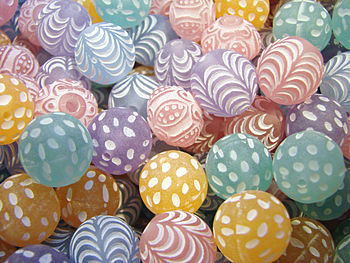Online sales are temporarily suspended !!
Contact the seller in advance before paying for the order!
Glass Beads
A Blessed Gift From Ancient Egypt
Part 1

What would jewelry making be without glass beads? Not particularly fun and very limited, I would guess. Thanks to the Egyptians we can indulge our self in a world filled with beautiful beads, pendants and lots of other things made of glass, colored and manipulated in ways the Egyptians could only dream about.
What did they know back then about to which extent the use of glass would develop over time. That the whole world greedily and happily would press their invention to their chests and declare it one of the worlds most treasured and versatile materials.
Today we take glass pretty much for granted. We have it everywhere around us in shapes of windows, glasses, bottles etc. Glass beads are generally looked upon as something cheap and easy to come by. The mass production of beads that took place after the industrial revolution must take most of the blame for this. However as a jewelry maker you know differently.
Glass beads are so much more than glass pressed into a mold to make thousands of the same shape. Making beads of glass has always been, and still is, an art form. Beads are still hand made and hand blown into fabulous artistic statements.
Beads come in all kinds of qualities, shapes and prices, and sometimes it can almost be a bit overwhelming because there is SO much to choose from. What is what? How can you know the difference between a pressed bead and a hand made bead, between a mass produced one and a artistic one of the kind bead?
Let's go through the different types of beads, and see if we can clear this up a bit. Maybe it will make it easier for you to choose the right beads for your projects.
Czech glass beads:
The Czech/Bohemian glass bead industry began around 15th century in Jablonec, Stanovsko and Bedrichow. However records tell that glass beads were colored and faceted as substitutes for gemstones already in the 13th century, and that beads for rosaries were made since the roman times.
In the 17th century they began to compete with the Venetian bead production. Bohemia began a market research where they sent “sample men” around the world, asking people what kind of beads they wanted. Taking their research results with them home to Bohemia and producing what people had told them they wanted, was a huge success, and put them on the map as one of the leading bead producers in the world.
For Europeans the use of beads in trading abroad was a blooming enterprise. Bohemia gave the Venetians hard competition when it came to producing trade beads, and eventually surpassed them and became the worlds leading manufacturer of trade beads.
Two world wars and a communistic regime took its toll on the bohemian bead industry in the 20th century, but they have now begun to rise from the dust, and are again one of the worlds largest glass bead manufacturers.
In the beginning to middle of the 1900, pressed beads from Jablonec bloomed. After the finding of Tut Ankahmons untouched tomb in Egypt in 1922, people wanted exotic looking glass beads that resembled those found in the tomb.
Jablonec, faithful to what the people wanted, mass produced beads in Egyptian and oriental styles. Unfortunately these beads were of poor quality, but since they came with a low price, they became hugely popular. Today you can find these beads in flea markets and antique stores around the world.
Glass beads from the Czech republic are very popular today, because of the huge variety in shapes, colors, finishes and sizes. They are also the worlds largest producer of seed beads. Different techniques are used to produce different kinds of beads. Most are made by pressing molten glass into molds, and then add a a variety of finishes like metal or Aurora-borealis (AB).
The most commonly used Czech beads today are:
 Druc beads:
Druc beads:
Druc simply means round, and that's what these beads are. These are pressed round glass beads, that comes in a huge variety of colors and finishes. The beads are optically polished to give them a scratch free surface. Druck beads are suitable for most bead works, and give you pretty and durable beads for a low price.

Fire polished beads:
These are faceted glass beads, colored and coated into a wide spectra of variations. The beads are machine faceted and then coated and polished inside a red hot oven, hence the name fire polished.
These are really lovely beads that you can use for mostly everything. Their facets and warm sparkle make them a worthy substitute for Austrian crystals. You can get them round, rondelle and coin shaped. The round ones are actually a little bit oval, something to be aware of if you need perfectly round beads for your project.
 Pressed beads:
Pressed beads:
Molted glass pressed into molds to create different shapes are mass produced in the Czech republic. They vary slightly in quality, from beautifully shaped flowers to leafs where the pressed seam is still showing. But there are many shapes and colors to choose from, so go crazy and dig in.
With these beads you can make great jewelry designs with flowers, leafs, daggers and drops, all with finishes like etched, metal, aurora borealis, transparent and opaque. And the best: they are relatively cheap in price.

Cathedral beads:
These are very nice beads, that are pressed in steel molds that give them a kind of faceted exterior. They are then grinded and polished. Each end have a metallic texture that resembles a kind of bead cap. They give an extra little spike to a piece of jewelry, both because of their lovely colors and finishes, but also because of the metal coatings on the ends.

Chewron beads:
Now we have to move from Bohemia to Venice in Italy. Venice was the only producer of these somewhat special beads. I say was, because since the 1950 only a very small amount of these beads have been made in Italy.
Chewron bead were used mainly as trade beads in the end of the 15th century.
The beads were build from several layers of glass. First a hollow cane was made from blowing air into molten glass. Then 6 layers of colored glass were put around it in the following order: white, blue, white, brick red, white and finally blue. For each layer added, the hot, molten glass was plunged into a star shaped mold, creating a star shaped pattern for each layer. When all layers were applied, the glass was drawn/stretched into a long cane. The air bubble inside the cane stretched with it and formed the hole in the beads.
When stretched to the wanted length/diameter, the glass was left for cooling and then cut into segments, each becoming a bead. The segments were then ground to reveal the inner layers and the star pattern, and a true Chewron bead was born.
If the cane was just cut, leaving the ends flat, the beads were not reckoned as Chewron beads, but called Rosetta or star beads.
The star pattern consisted normally of 5 concentric stars with 12 points. But variations have been made. Almost all the beads were made in red, white and blue (which by the way are the colors of the Norwegian flag), but a small number were made in other colors.
The Chewron beads were mainly exported to the West Africa and America as trade beads and were hugely popular among the natives. Today the beads are popular as collector items.
As mentioned earlier only a small amount of these very characteristic beads are still made in Venice, but other countries like India and China produces them today. The Chinese use the Venetian technique with a star shaped mold, but in India they don't. Therefor the Indian star patterns have slight indentations.

Crow and Pony beads:
While we talk about trade beads, Crow and Pony beads were also used in the trading business, but mainly on the American continent. Therefor these beads are mostly associated with the native Americans.
Whether the Crow beads have got their name from or after the Crow tribe, I don't know, but I believe there is a connection there somewhere. Crow-, Pony- and Seed beads have been used in the ceremonial costumes of the native Americans for centuries. It is said that the Europeans brought these beads to America about 500 years ago, and that they quickly became part of the American Indian culture.
These large seed bead-looking beads have a historic significance in the Indian culture, and the placement and color of each bead is a visual reminder of a story or a performed ritual. Crow beads are somewhat larger than the Pony beads, and both have been created by hand by the native Americans and shaped from wood, transparent and opaque glass. Today they are produced in glass, plastic, and wood.
Visually there is not much to these beads. They are shaped like seed beads, but are significantly larger. They are roughly made and often from semi-translucent glass with a variety of finishes. The holes are large, so they are perfect for stringing on leather cord, Buna cord and other thicker stringing materials. They also come at a low price. Although plain, these oversized seed beads, are actually quite charming, so don't hesitate using them in your jewelry projects.
 Milleriori beads:
Milleriori beads:
We are back in Italy, where Millefiori means thousand flowers. These beads are formerly known as Mosaic beads, and were also produced for trading. They are called Thousand flowers, because of the way they are made.
Lots of different colored glass canes, called Murrines, are put together into a pattern and then fused together. The beautiful mosaic pattern is only visible through the cut of the cane. This technique can be traced back to ancient Rome, and Millefiori canes have been found in graves in Ireland, dating back to the 8th century.
The knowledge of the technique used to make these magnificent beads was lost for a long time, and was not retrieved until the 19th century.
Interesting enough this is a technique that has been applied to other medias, like Polymer clay. Polymer clay canes need no fusing, and the patterns can easily be build up with several canes and baked in your own kitchen stove. Because of this, Millefiori is easier to make with Polymer clay than with glass.
Of course, there is one big difference between the two; Polymer clay is porous and glass is not. Therefore a real Millefiori glass bead will last close to forever (unless broken). A Polymer clay millefiori bead will have its limited lifetime due to contamination, wear and tear.
Millefiori beads are used in lampworking, where slices of millefiori canes are fused onto molten glass cores. Today you can buy millefiori beads cheap from China and India, and of course from its original country of birth, Italy.
Go to Glass Beads Part 2
Return from Glass Beads to Jewelry Beads
Go to Home Page
Leave a comment ,
I would love to hear your opinion on this page. Good or bad, it will help me making this Site better.










